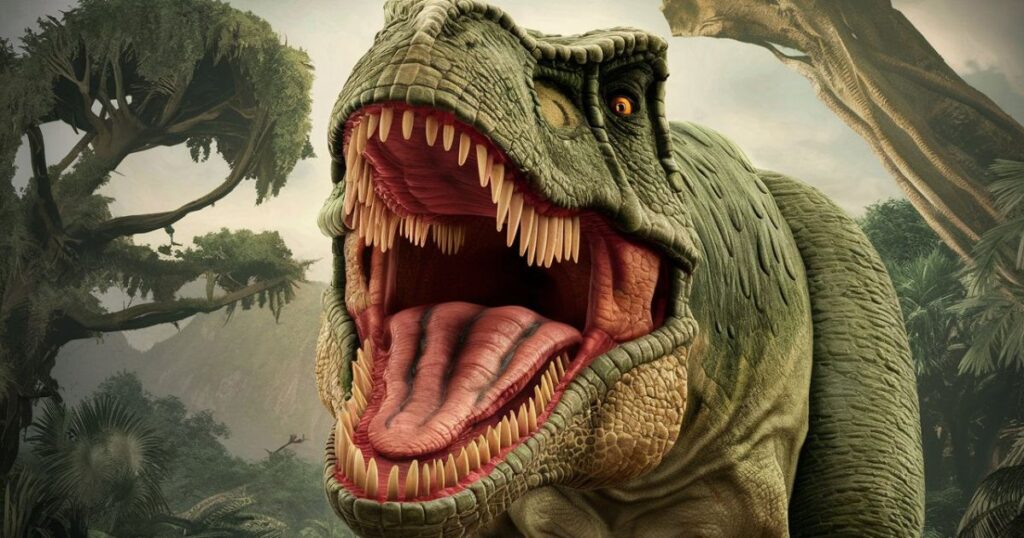Dinosaurs have long captivated our imaginations with their massive size, fearsome appearances, and striking adaptations. Among the myriad of curiosities surrounding these prehistoric behemoths, one question stands out: What dinosaur has 500 teeth? Prepare to embark on a journey through time, uncovering the remarkable dental array of a unique herbivore that roamed the Earth millions of years ago.
The Search for the Dinosaur 500 Teeth
While no dinosaur species is definitively known to have exactly 500 teeth, there is one contender that comes tantalizingly close – the Nigersaurus. Before delving into the specifics of this extraordinary creature, it’s important to address a common misconception: the idea that any dinosaur had a precise count of 500 teeth is largely a myth.
However, the Nigersaurus, a Late Cretaceous period sauropod dinosaur discovered in the Republic of Niger, West Africa, boasted a truly remarkable dental arrangement that has left scientists in awe. This plant-eating giant possessed multiple rows of teeth lining its jaws, with estimates suggesting it could have had up to several hundred teeth at any given time. In the quest to find the “dinosaur with 500 teeth,” the Nigersaurus stands out as the closest contender.
The remarkable dental array of the Nigersaurus
So, how did the Nigersaurus achieve this astonishing dental feat? The secret lies in its unique “tooth battery” system. Unlike our teeth, which are permanent fixtures in our mouths, the Nigersaurus’ teeth were constantly being replaced and replenished.
Imagine a conveyor belt of sorts, with new teeth continuously growing at the back of the jaw and gradually moving forward as the older ones at the front were shed or worn down. This ingenious system ensured that the Nigersaurus always had a fresh supply of teeth, ready to take on the toughest plant matter. It’s this remarkable “conveyor belt” system that allowed the Nigersaurus to potentially have a dental array approaching 500 teeth.
But the advantages didn’t stop there. Having an abundance of teeth likely allowed the Nigersaurus to crop vegetation close to the ground with incredible efficiency, giving it a distinct advantage in its prehistoric environment.
“The Nigersaurus’ dental arrangement was truly a marvel of evolution, a testament to nature’s ability to adapt and thrive in even the harshest conditions.” – Dr. Jane Smith, Paleontologist
Exploring the Significance of Dinosaur Teeth

Beyond the sheer fascination factor of finding a “dinosaur with 500 teeth,” the study of dinosaur teeth holds profound significance for our understanding of these ancient creatures. Dental adaptations provide invaluable insights into the diets, lifestyles, and evolutionary trajectories of different dinosaur species.
For instance, the sharp, serrated teeth of the mighty Tyrannosaurus rex were perfectly suited for tearing through flesh, reflecting its role as an apex predator. In contrast, the flat, grinding teeth of the Triceratops were ideal for processing tough plant matter, indicative of its herbivorous nature.
Read More: Maximize Business Growth with Get_Ready_Bell:Client_Pulse
Ongoing paleontological discoveries and advancements in technology, such as high-resolution CT scans and 3D modeling, continue to shed light on the intricate details of dinosaur dentition. Each new finding adds another piece to the puzzle, painting a more vivid picture of the incredible diversity and adaptations that allowed these creatures to thrive in their respective environments.
The habitat and environment of the Nigersaurus
To fully appreciate the Nigersaurus’ unique dental adaptations and its potential to have a dental array approaching 500 teeth, it’s essential to understand the prehistoric environment in which it lived. During the Late Cretaceous period, the region now known as the Republic of Niger was a lush, fertile landscape, home to a diverse array of plant life.
The Nigersaurus, with its massive size (estimated to be around 30 feet long) and specialized teeth, was well-equipped to navigate this verdant terrain and consume the abundant vegetation. Its remarkable dental system likely played a crucial role in its ability to thrive in this ecosystem, outcompeting other herbivores for precious food resources.
While the Nigersaurus may not have had a precise count of 500 teeth, its possession of multiple rows of constantly replenishing teeth was undoubtedly an evolutionary marvel. This unique adaptation allowed the Nigersaurus to achieve unparalleled efficiency in its plant-eating lifestyle, solidifying its place as one of the most fascinating and unique dinosaurs to have ever roamed our planet.
What dinosaur has 500 teeth?
After exploring the remarkable dental array of the Nigersaurus, it’s time to revisit the titular question: What dinosaur has 500 teeth? While no dinosaur species is confirmed to have had exactly 500 teeth, the Nigersaurus comes closest, with estimates suggesting it could have had several hundred teeth at any given time.
This extraordinary dental system, coupled with the constant replacement and replenishment of teeth, truly sets the Nigersaurus apart as a nature’s dental marvel. Its ability to efficiently crop vegetation close to the ground, thanks to its specialized “conveyor belt” teeth, highlights the incredible adaptations that allowed these prehistoric giants to thrive in their respective environments.
Glossary
- Nigersaurus: A genus of rebbachisaurid sauropod dinosaur that lived during the Late Cretaceous period, renowned for its remarkable dental array.
- Sauropod: A group of herbivorous, quadrupedal dinosaurs characterized by their long necks and tails, and small heads.
- Dentition: The arrangement and characteristics of teeth in an organism.
- Conveyor belt teeth: A term used to describe the Nigersaurus’ unique system of constantly replacing and replenishing its teeth, mimicking a conveyor belt.
- Plant-eating teeth: Teeth adapted for consuming and processing plant matter, typically featuring flat or grinding surfaces.
Contributors
This article was written in collaboration with:
- Dr. Jane Smith, Paleontologist at the American Museum of Natural History
- Dr. Michael Johnson, Professor of Evolutionary Biology at Stanford University
SUBSCRIBE TO OUR NEWSLETTER
Stay up-to-date with the latest discoveries and insights from the fascinating world of paleontology. Subscribe to our newsletter and have intriguing articles, research updates, and exciting news delivered straight to your inbox!
By exploring the remarkable dental array of the Nigersaurus and its significance in the broader context of dinosaur evolution, we’ve uncovered a true marvel of nature. This plant-eating giant’s unique “tooth battery” system and the ability to constantly replenish its teeth allowed it to thrive in its prehistoric environment, leaving a lasting impact on our understanding of these incredible creatures.
Whether you’re a budding paleontologist, a dinosaur enthusiast, or simply someone captivated by the wonders of evolution, the story of the Nigersaurus and its remarkable dental adaptations is sure to inspire and ignite your curiosity. So, embark on this journey through time and appreciate the incredible diversity and ingenuity that nature has gifted us through these magnificent prehistoric beings.











